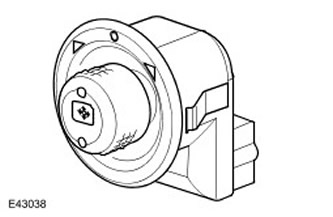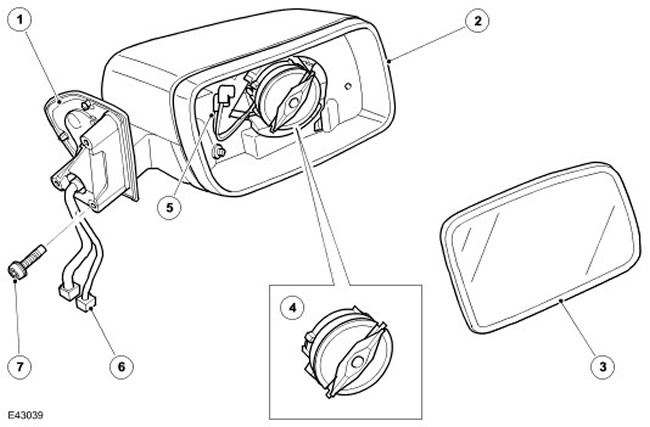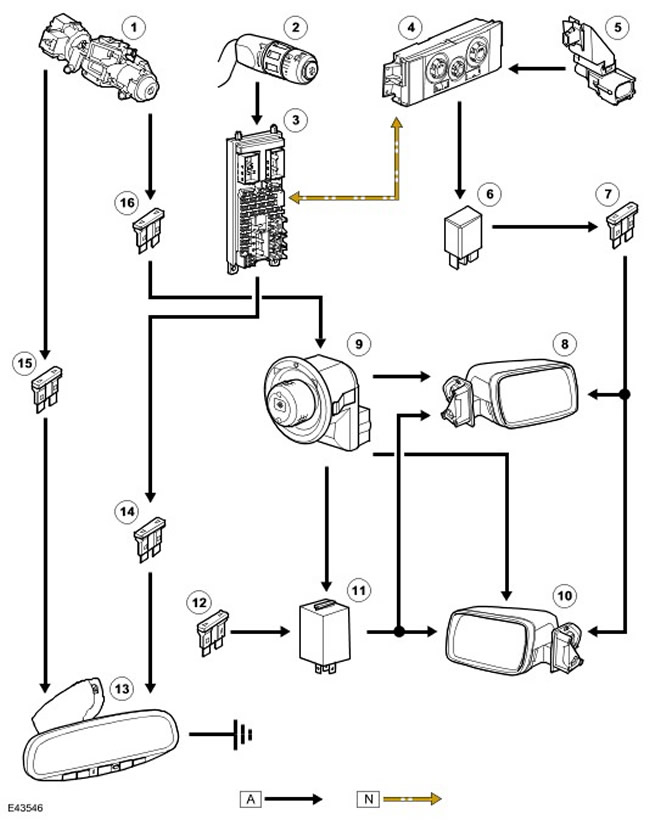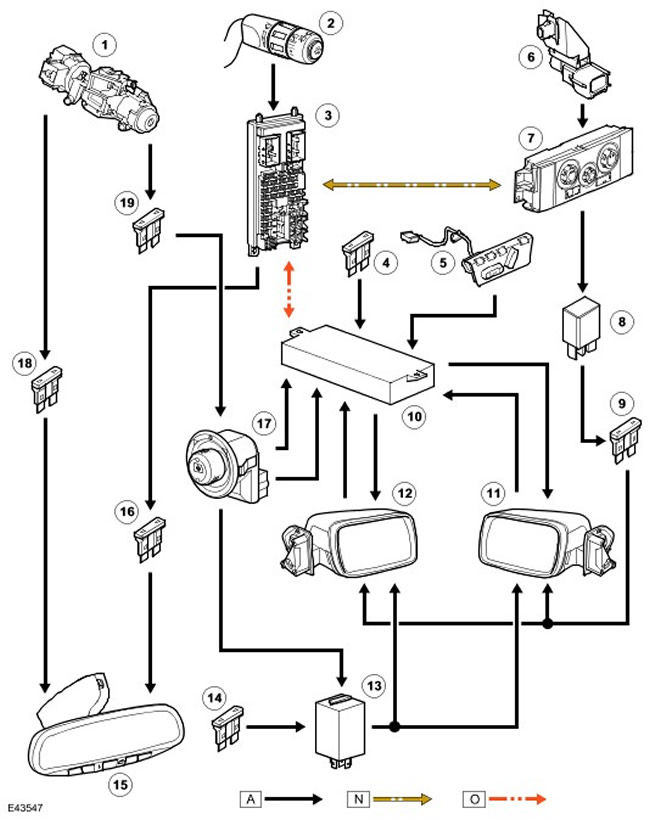Parts location
NOTE: RHD model shown (left hand drive model), LHD (right hand drive model) similar.

| Item name | Spare part number | Description |
| 1 | - | outside mirror |
| 2 | - | Interior mirror (auto-dimming model shown) |
| 3 | - | Exterior mirror adjuster |
| 4 | - | Relay for heaters for windshield washer jets/outside rear-view mirrors |
| 5 | - | Folding module |
General provisions
Rear-view mirrors include an interior mirror above the windshield and an exterior mirror mounted on the panel of each of the front doors.
Interior mirror with manual dimming

Auto-dimming interior mirror

| Item name | Spare part number | Description |
| 1 | Rear light sensor | |
| 2 | Front light sensor |
Auto-dimming interior mirror with built-in universal transmitter

| Item name | Spare part number | Description |
| 1 | - | Channel 1 button of universal transmitter |
| 2 | - | Channel 2 button of universal transmitter |
| 3 | - | Status indicator |
| 4 | - | Channel 3 button of universal transmitter |
| 5 | - | Rear light sensor |
| 6 | - | Dimming button |
| 7 | - | Dimming off button |
| 8 | - | Front light sensor |
The interior rearview mirror has manual or automatic dimming. With manual dimming, the mirror is moved to the dimming position by a lever on the bottom of the mirror housing. Auto-dimming is provided by the electrochromic mirror glass.
Depending on the configuration and market, the mirror can be equipped with a universal transmitter of the HomeLink® system.
NOTE: HomeLink is a registered trademark of Johnson Controls Inc.
Mirrors with a universal transmitter and/or auto-dimming function are connected to the on-board electrical wiring using a connector located under the cover trim in the mirror leg. The universal transmitter and/or auto dimming interior mirror is powered by the CJB when the ignition is turned on (in position II).CJB (central distribution block)
The light sensors on the front and rear of the mirror are the signal sources for the auto dimming device.
Mirrors with a universal transmitter on the lower edge have buttons for controlling the transmitter and the auto-dimming function. The back of the mirror also has a two-color indicator that glows green when auto dimming is activated and red when using the universal transmitter.
Auto Dimming
An interior mirror with this function automatically dims to reduce glare from the headlights of rear drivers at night or in low light conditions. The auto dimming function only works when the ignition is on (position II).
The automatic dimming function of interior mirrors with a universal transmitter can be turned off using the corresponding buttons on the bottom of the mirror. When the ignition is turned on, the dimming function is enabled by default. When the auto dimming function is enabled, the green status indicator lights up.
For mirrors without a universal transmitter, the auto-dimming function is always on when the ignition is on (position II).
When the auto dimming function is enabled, the sensor on the front of the mirror measures ambient light, and the sensor on the back of the mirror monitors the headlights of vehicles behind. When the brightness of the light from the rear exceeds the ambient light level, the mirror will be automatically dimmed. Dimming is prohibited when reverse gear is engaged. The reverse gear signal is supplied from the reverse gear relay in the CJB central junction box (central switching unit).
Universal Transmitter
The universal transmitter can remotely control up to three systems (e.g. garage and house doors, turning on lights or burglar alarms), replacing the need for remote controls for each of these systems. Universal transmitter operates in the range from 288 to 419 MHz (except for the bands 322 to 335.4 MHz and 399.9 to 410 MHz).
WARNING: The Universal Transmitter must not be used with garage doors that do not have an emergency stop and reverse function as required by federal safety regulations (such devices include gate and door openers manufactured before April 1, 1982). Door control mechanisms that are not equipped with devices for detecting an object in the path of a closing door and automatically stopping and reversing the door do not meet current safety standards. Using remote control doors that do not have these devices increases the risk of serious injury or death.
The universal transmitter has three channels with a separate control button for each channel. When one of the buttons is pressed, the universal transmitter transmits a radio signal on the corresponding channel, and the red status indicator lights up, confirming the transmission of the signal.
The universal transmitter is programmed using the remote controls as follows:
- Turn the ignition switch to position II.
- Press and hold the two outermost buttons of the Universal Transmitter until the red status light starts flashing, then release the buttons. This achieves the initialization of the transmitter and the removal of the previous settings of all three channels from the memory.
- Point the remote control with the emitting side towards the underside of the interior rearview mirror.
- Simultaneously press and hold the remote control button and the universal transmitter button selected for that channel. When the red status indicator flashes rapidly, channel programming is complete, release the buttons (the red status light flashes slowly at first and may take up to a minute to flash quickly).
- To program another channel on the Universal Transmitter, repeat steps C and D.
- Turn the ignition switch to position 0.
CAUTION: When programming a universal transmitter near a controlled system, that system may become operational. If the system controls the gate or door of the house, make sure there are no people or objects to avoid injury to people or damage to objects when the gate or door moves.
The radio signals that control some opening systems include a coded security feature. After programming the channel using the hand-held remote control, it is necessary to train the system to receive a signal from the universal transmitter. To check if the system is coded, press the appropriate button on the universal transmitter.
If the red status indicator flashes for 1 or 2 seconds before turning solid, this indicates that the system is equipped with a coded security feature.
The system is trained to receive a signal from a universal transmitter as follows:
- On the learning system, find the learn button (see corresponding system description).
- Press the learning button for 1-2 seconds and complete step C within 30 seconds.
- In the car, press and release the corresponding button on the universal transmitter twice. The receiving system is now trained to receive the universal transmitter signals.
- If the system does not work, repeat step C, but press and release the universal transmitter button three times.
Exterior mirrors
Exterior mirrors on all models are electrically heated and electrically adjustable. Depending on the vehicle equipment and the country of delivery, the mirror may have the function of folding, returning to a memorized position and tilting when reversing.
Heating
Heating elements glued to the back of the mirror are used to heat the mirrors. The power supply to the heaters is controlled by the ATC controller. ATC (automatic temperature control)
Windshield washer jet heaters and door mirror heaters are always ready for operation when the ignition is on (position II.) Heaters are controlled by PWM signal (pulse width modulation), which is supplied every 30 seconds from the ATC module (automatic temperature control) to the windshield washer and exterior mirror heating relay coil located in the BJB battery junction box (.) When power is applied to the relay, it closes the power circuit of the heaters. Power supply heaters ATC controller (automatic temperature control) adjusts the duty cycle of the PWM control signals (pulse width modulation) depending on the outside temperature and the condition of the windshield wipers. In the initial period after the ignition is switched on to position II, the ATC controller (automatic temperature control) sets the duty cycle of the PWM signal (pulse width modulation) equal to 100%. The length of this period depends on the outside temperature. After the end of the initial period, the duty cycle is adjusted in accordance with the condition of the wipers.
Duty cycle of control signals for external mirror heaters

Adjustment
Each exterior mirror contains two position adjustment motors. One motor is designed to adjust the position in the horizontal plane (left-right), the second - for adjustment in the vertical plane (up down). The operation of the electric motors can be controlled using the exterior mirror position control located in the switch panel in the driver's door. Position adjustment is possible when the ignition switch is in position I or II.
The exterior mirror adjuster is a joystick rotary switch. The choice of an external mirror for adjustment is carried out by turning the switch to the left or right of the middle position. Tilt the switch to apply power and «masses» to the corresponding motor and to moving the mirror in the corresponding direction. When the switch is tilted in the opposite direction, the switching polarity is reversed and the mirror moves in the opposite direction.
If the vehicle is equipped with a save and recall system, all connections from the outside mirror to the motors go through the memory controller. For more information contact Seats (501-10 Seating)
Exterior mirror adjuster

Recalling settings from memory
On vehicles equipped with a save and recall system, each mirror motor is equipped with a feedback potentiometer that reports the current mirror position to the memory controller. The positions of the exterior mirrors and driver's seat are memorized in two ways:
- Manually, using the save and reset buttons.
- Automatically, when implementing the comfort landing function, when the ignition switch is turned from position II to position I.
Stored positions can be recalled from memory, both while driving and when the vehicle is stationary. When the vehicle is stationary, briefly pressing the reset button resets the exterior mirrors and the driver's seat to the position stored in the corresponding button, provided the driver's door is open or the ignition switch is in position I or II. When the recalled position is reached, a double chime sounds and the information center displays the message (if configured). If, while moving the mirror to the position recalled from memory, press the button (in any direction) position, mirror movement will stop immediately.
To prevent inadvertent activation of the position control while the vehicle is moving, the reset button must not only be pressed but also held down.
If the memory controller does not register a change in the signal from the potentiometer feedback signal for 100 ms or more during a move to a memory recalled position, the memory controller considers this as a drive motor seizure. If a stuck motor is detected, the use of that motor is stopped until the memory recall operation is completed. The motor can be reactivated by pushing the switch in the desired direction.
Each time the ignition switch is switched from position II to position I, the memory controller automatically stores the position of the exterior mirrors and the driver's seat together with the ignition key identification code. When the Easy Entry function is activated, when the vehicle is unlocked with the remote control, the memory controller compares the stored positions of the mirrors and the driver's seat with the current position for the key with this ID number. If there is a discrepancy in the data, the memory controller moves the outside mirrors and the driver's seat to the position stored in the memory. If the lock button on the remote control is pressed during the easy landing operation, the movement of the mirrors and the seat will stop immediately.
The door lock command is transmitted to the memory controller from the CJB unit (central switching unit) over the local LIN bus. The Comfort Fit function can be enabled or disabled through the user settings menu. For more information, please refer to the Information and Message Center (413-08)
Outside mirror

| Item name | Spare part number | Description |
| 1 | - | Main frame |
| 2 | - | Mirror body |
| 3 | - | Mirror glass |
| 4 | - | Adjustment motors in the vertical and horizontal plane |
| 5 | - | Lucar Heating Element Connectors |
| 6 | - | Electrical connectors C0319 and C1563 |
| 7 | - | Screw (x 3) |
Tilt mirror when reversing
On vehicles with memory recall, both outside mirrors automatically tilt down when reverse gear is engaged (the ignition switch must be in position II).
When the selector is moved from the reverse position, the exterior mirrors return to their original position. The tilt of the mirror when reversing is controlled by the memory controller.
The tilt positions of the mirrors are programmed in the memory controller initially for each ignition key. If you change the position of the exterior mirrors while in reverse gear and initiate the save procedure, the previous positions will be replaced by the new ones. The next time reverse gear is engaged, the new mirror tilt position will be recalled for that ignition key. Storing the positions of the outside mirror with the reverse gear engaged only affects the tilt of the mirror when reversing, the rest of the settings stored in the memory remain unchanged.
On vehicles equipped with an automatic transmission, there is a half-second delay after reverse gear is engaged and before the mirror moves. This delay prevents unnecessary movement of the mirrors when the selector is moved from Park to Drive.
Mirror tilt function when reversing can be enabled or disabled via the user settings menu.
Folding mirrors
Folding mirrors have an additional electric motor located in the outside mirror hinge. The folding motor is controlled by the door mirror adjuster and the folding module.
The folding module is mounted directly on the outside of the CJB (central switching unit) and controls the power supply to the folding motors.
When the door mirror control is in the middle position (turned off), tilting the switch down turns on the feed «masses» to the folding module. When the folding module receives a signal «masses» the first time, the folding module supplies power to the folding motor and «mass» and the mirror folds up. When the switch is pressed again, the power-on polarity and «masses» changes and the engine opens the mirror. If the switch is pressed while the exterior mirrors are moving, they stop and move back to their original position. If one of the mirrors has been manually folded in, the mirrors can be re-synchronized by performing a mirror folding and unfolding work cycle.
To prevent overheating of the folding motor, the folding function is inhibited for 3 minutes if this function is selected ten times within 60 seconds. If the tenth request occurs within 60 seconds, the mirrors will only expand, the folding request will be ignored.
Connector C0907 of the folding module on the harness side

Connector pins C0907 of the folding module on the harness side
| contact no | Name | Input signal / output signal |
| 1 | «Positive» And «negative» folding motor contacts | Input signal / output signal |
| 2 | Fold signal from door mirror adjuster | Input |
| 3 | «Positive» And «negative» folding motor contacts | Input signal / output signal |
| 4 | Power supply from fuse 16 of the CJB (central switching unit) | Input signal |
| 5 | "Weight" systems | Output signal |
| 6 and 7 | Not used | - |
Control System Diagram (exterior mirrors without memory function)
NOTE: A = Conventional wiring; N = Medium speed CAN bus (controller LAN)

| Item name | Spare part number | Description |
| 1 | - | Egnition lock |
| 2 | - | Wiper switch |
| 3 | - | CJB () |
| 4 | - | ATC module (automatic temperature control) |
| 5 | - | Outdoor temperature sensor |
| 6 | - | Relay for heaters for windshield washer jets/outside rear-view mirrors |
| 7 | - | Fuse 16E, BJB block (.) |
| 8 | - | Right exterior mirror |
| 9 | - | Exterior mirror adjuster |
| 10 | - | Left exterior mirror |
| 11 | - | Folding module |
| 12 | - | Fuse 16P, block CJB (central switching unit) (battery powered) |
| 13 | - | Interior mirror |
| 14 | - | Fuse 5P, block CJB (central switching unit) (from reverse signal relay) |
| 15 | - | Fuse 69P, CJB block (central switching unit) (ignition) |
| 16 | - | Fuse 33P, block CJB (central switching unit) (auxiliary power) |
Control System Diagram (exterior mirrors with memory function)
NOTE: A = Conventional wiring; N = Medium speed CAN bus (controller LAN); O = LIN bus

| Item name | Spare part number | Description |
| 1 | - | Egnition lock |
| 2 | - | Wiper switch |
| 3 | - | CJB () |
| 4 | - | Fuse 46P, block CJB (central switching unit) (battery powered) |
| 5 | - | Seat adjustment and remote control with memory function |
| 6 | - | Outdoor temperature sensor |
| 7 | - | ATC module (automatic temperature control) |
| 8 | - | Relay for heaters for windshield washer jets/outside rear-view mirrors |
| 9 | - | Fuse 16E, BJB block (.) |
| 10 | - | Memory controller |
| 11 | - | Left exterior mirror |
| 12 | - | Right exterior mirror |
| 13 | - | Folding module |
| 14 | - | Fuse 16P, block CJB (central switching unit) (battery powered) |
| 15 | - | Interior mirror |
| 16 | - | Fuse 5P, block CJB (central switching unit) (from reverse signal relay) |
| 17 | - | Exterior mirror adjuster |
| 18 | - | Fuse 69P, CJB block (central switching unit) (ignition) |
| 19 | - | Fuse 33P, block CJB (central switching unit) (auxiliary power) |
Comments on this article